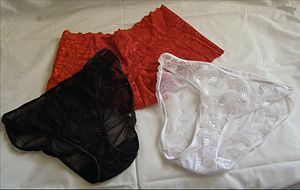Panties
This article needs additional citations for verification. (June 2016) |

Panties in American English (typically called knickers in British English) are a form of underwear worn by women. Panties are most often form-fitting, but may also be loose. Typical components include an elastic waistband, a crotch panel to cover the genital area (usually lined with absorbent material such as cotton), and a pair of leg openings that, like the waistband, are often made of elastic. Various materials are used, but are usually chosen to be breathable.
While panties were originally designed to cover the entire lower half of the female torso,[1] since the 1970s panties have had either no legs or, in some cases, very short ones, and have become increasingly briefer over time.
Terminology
In countries such as the United Kingdom (UK), Ireland, South Africa, and occasionally in other Commonwealth countries such as Australia[2][3] and New Zealand, panties are often referred to as "knickers" or "undies". In Australia, men's underpants are often referred to as "undies".[4] The term is little used in the United States (US) and Canada, where the term "panties" is usually favoured. In the UK, the term "pants" is also used for both men and women's underwear (not to be confused with the North American usage of pants, which refer to what both Americans and the British call "trousers", although this term is also used in some parts of Northern England).
Styles

Panties are classified into various styles based on criteria such as the amount of rear coverage, width at the sides and height at which they are worn. These categories are not necessarily distinct and usage may vary somewhat among brands:[5]
- Briefs rise to the waist, or just below the navel, and have full coverage in the rear.
- Classic briefs feature sides that extend below the hip. Sometimes these are called "granny panties" by young women.
- High-cut briefs are designed with sides that are somewhat narrower.
- Control briefs are designed to offer support while giving a slimmer appearance. This type usually contains a stretch material such as spandex and may extend above the waist.
- Hipsters are worn lower down on the body, with the waistband around the hips.
- Boyleg (or boyshorts) are styled after men's boxer briefs and have short legs extending below the crotch.
- Bikinis sit at hip level, like the hipsters, but the fabric of the side sections is narrower. With the string bikini type, the side sections disappear altogether and the waistband consists of only string-like material; also, the rear coverage of the bikini is more revealing than that of the brief.
- Tangas provide a moderate to minimal coverage with back coverage that is less than a bikini, and the waistband is reduced to a narrow strip at the sides.[6]
- Thongs have a waistband similar to tangas, but the rear coverage is mostly cut away. The crotch is extended to the back of the wearer and a narrow strip of fabric fits between the buttocks, becoming wider towards the top.
- The G-string has a vertical string at the back, which connects the crotch to the waistband, sometimes featuring a triangle of fabric.
Panties are made of a variety of materials and fabrics, including satin, silk, PVC, cotton, nylon, mesh, lace, rawhide, leather, latex, lycra, and polyester. Construction typically consists of two pieces (front and rear) that are joined by seams at the crotch and sides; an additional gusset is often in the crotch, with the waistband and leg-openings made from elastic.
Wearing style

Though women are often shown wearing panties under a garter belt with stockings, panties are actually worn over the garters to allow the panties to be easily pulled down or removed without unfastening the garters. If wearing low shapewear, or a girdle, with attached garters, tap pants or panties with side ties may be the only practical options apart from unfastening the garters.
History
The earliest known use of underwear that resembles modern panties dates back to 4,400 B.C. during the Badari period in Egypt.[7] Statuettes found in Badari tombs show the modern panty as we know it today: triangular in shape with very little cloth around the hips. Most modern cultures have created their own style of underwear, but modern panties closely resemble those that adorn Badarian statuettes.
See also
References
- ^ Staff (7 February 2008). "Panty". The Origin of. TheOriginOf.com. Retrieved 13 May 2012.
- ^ "Say 'NO' to dodgy knickers". thehoopla.com.au. 12 November 2013. Retrieved 16 December 2014.
- ^ "Hole Proof - No Knickers". Bonds underwear, Australia. 1985. Retrieved 16 December 2014.
- ^ "Translations of Australian English words into American English - Fiona Lake". Retrieved 23 March 2015.
- ^ Parkinson, Ann (2011-09-09). "Women's Panties - LoveToKnow Lingerie". Lingerie.lovetoknow.com. Retrieved 2011-09-13.
- ^ Jennifer Carroll; Kathy Schultz (1 October 2009), Underneath It All, Harlequin, p. 41, ISBN 978-1-4268-4072-2, retrieved 14 September 2013
- ^ http://ebooks.lib.ntu.edu.tw/1_file/etana//15271.pdf
External links
 Media related to Women's knickers at Wikimedia Commons
Media related to Women's knickers at Wikimedia Commons
